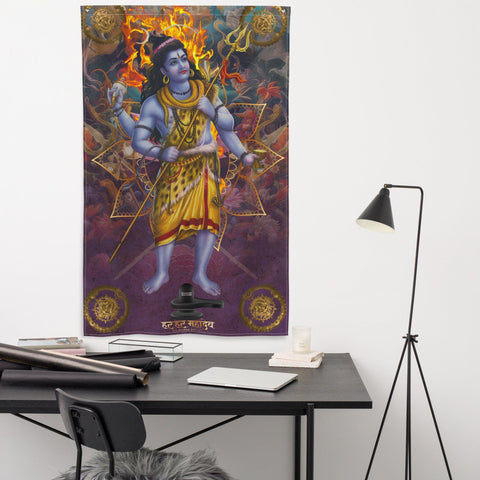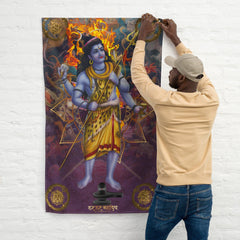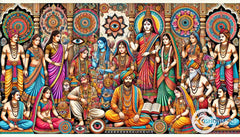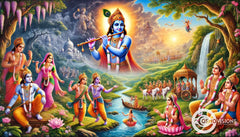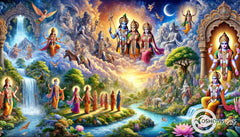Shiva Symbol: Meaning Behind Every Icon of Lord Shiva
Posted by Massimiliano Geraci
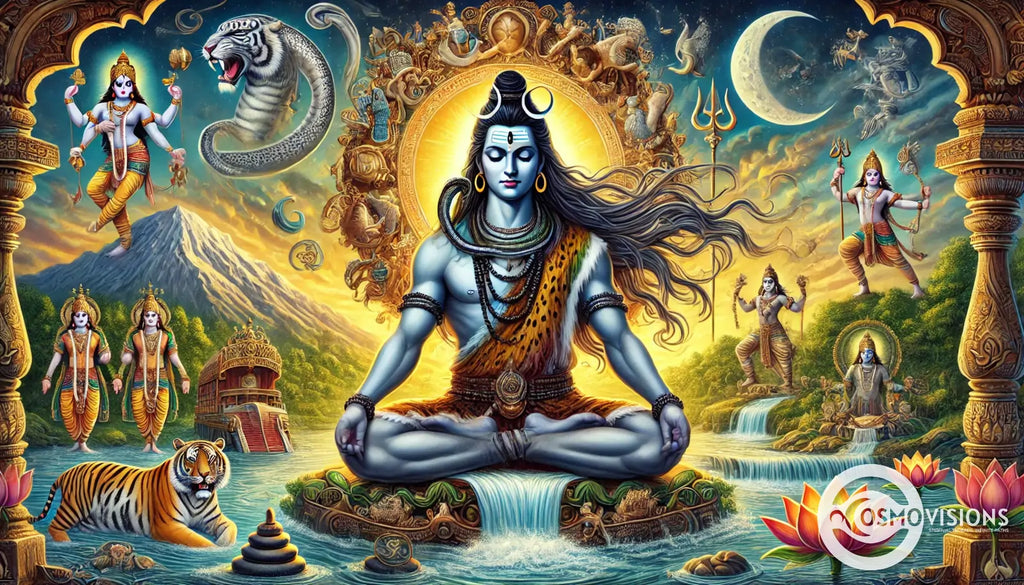
Exploring the symbols of the Hindu god Shiva can often feel like trying to understand a vast and intricate tapestry woven from the threads of spirituality, mythology, and philosophy. Many find themselves drawn to this Hindu deity’s enigmatic presence, yet grapple with grasping the full depth of what his icons signify.
One intriguing aspect is how each symbol associated with Lord Shiva holds a universe of meaning that goes beyond simple representation, inviting believers into a deeper conversation with divinity.
Did you know that the Lingam is one of the most recognized symbols connected to Shiva, embodying both creation and destruction within its form? This article aims to demystify the profound symbolism behind Lord Shiva’s iconography—from his matted hair and ash-covered body to the cosmic dance of Nataraja.
Through detailed explanations and rich imagery, readers will embark on an educational journey that sheds light on these sacred symbols and encourages reflection on their own spiritual path.
Discover peace in understanding.
What Does the Shiva Symbol Represent?
Lord Shiva, recognized as Mahadeva in Hinduism, embodies the complex duality of creation and destruction, showcasing his power as both the destroyer and regenerator within the cosmos.
His symbols carry profound spiritual significance, each narrating a facet of his unparalleled attributes. The Shiva Linga symbolizes Shiva’s essence as formless (Nirgun Brahman), transcending human comprehension and representing universal creative energy.
This contrasts with his Saguna state, where he appears with form and qualities relatable to worshysical phenomena.
Shiva wearing tiger skin denotes victory over ego and illusion, illustrating his ascetic aspect as a great yogi who has complete control over primal forces in manifest world. The crescent moon on his head illustrates control over time cycles — waxing and waning signify creation’s cyclic nature under his dominion.
Similarly, ash smeared across his body represents purity of character by signifying eternal reality beyond death’s transient nature. Each element associated with Shiva — from the serpentine necklace indicating alertness in consciousness to Ganga flowing from his matted hair symbolizing purification — conveys deep metaphors for understanding life’s complexity through spirituality.

Who is Lord Shiva in Hinduism?
In Hinduism, Shiva stands as a paramount deity, revered as the ‘destroyer’ within the Trimurti, symbolizing the universe’s cycle of creation, preservation, and destruction. As part of the Hindu trinity, which includes Brahma and Vishnu, Shiva plays a crucial role in the cycle of creation, preservation, and destruction. His persona merges deep spiritual significance with cosmic roles, embodying both asceticism and the joys of household life.
Shiva’s body is often depicted with symbols rich in meaning: his matted hair denotes a rejection of societal norms and an embrace of nature; his third eye represents sight beyond the visible into areas of deep knowledge and truth. Shiva’s dance sets the cosmos in motion. His forms are many—Nataraja, Lingam—each manifesting aspects of existence and consciousness that resonate deeply in Shaivism and across broader Hindu traditions. As devotees worship Shiva at majestic temples on Mount Kailasa or by the banks of the holy river Ganga, they honor him not just as a god but also as a symbol for Purusha (spirit) opposing Prakriti (matter), ensconced in tales from ancient texts like Vedas to Puranas.
Moving forward explores why one such iconic representation—the Lingam—is central to understanding Shiva’s pervasive influence.
What Does the Lingam Symbolize?
The Shiva Lingam represents Shiva in Hindu temples, a symbol merging profound spiritual and cosmic energies. This icon embodies the mark of the lord within its creation, hinting at Shiva’s pervasive nature throughout the universe.
As a fusion of phallus masculine and feminine yoni shapes, it underscores the unity of male and female principles, reflecting essential aspects of creation and destruction in an eternal cycle. This sacred object stands as a conveyor of purity and peace, guiding devotees beyond space-time into higher consciousness realms.
Symbolizing both Shiva’s destructive power and his role as the auspicious one, the Lingam serves as a spiritual antenna for kundalini shakti awakening among practitioners. The presence of the moon as this symbol in worship places marks earth’s roundness and signifies time’s cyclic nature through moon phases controlling natural phenomena like tides.
Through meditation before the Lingam, worshippers connect with primal energies that fuel transformational shifts towards enlightenment, bridging earthly existence with transcendent realities beyond life and death cycles.

Why Shiva Wears Ash and Tiger Skin?
Moving from the significance of the Lingam, the attire of Lord Shiva offers another layer to the profound symbolism of Shiva's body. Shiva wears ash, showing that he is beyond life and death. Ash represents what remains after destruction, reminding devotees of the inevitable end all matter faces.
This act symbolizes acceptance of the cycle of birth, death, and rebirth. By covering himself in ash from cremation grounds, Shiva underscores his connection to this eternal cycle.
His choice of tiger skin as clothing goes deeper into symbolism. Tigers are considered symbols of power and embody sexual energy in Hindu philosophy. Wearing their skin signifies Shiva's control over primal instincts and power.
It also reflects his role as a protector of Dharma (righteousness) by keeping dangerous forces under check. This imagery resonates with worshippers by highlighting Shiva’s dual nature: his ability to destroy evil while nurturing creation’s balance through Yoga and meditation practices.
What are the Different Symbols Associated with Lord Shiva?
Lord Shiva embodies a multitude of symbols, each unraveling layers of profound meanings and cosmic principles. The ‘third eye‘ on Shiva’s forehead is not just an anatomical feature but represents the sight of knowledge, enabling him to see beyond the circle of life and death. The snake coiled around Shiva's neck represents time's cyclic nature and his mastery over earthly desires.
This ability allows Shiva to judge things at a deeper level, urging devotees to look past mere appearances. Furthermore, the crescent moon decorating his head serves as a symbol for time and the cycles of nature, illustrating how Shiva controls both high tides and low tides in human lives.
The River Ganga flows from the matted hair of Shiva, signifying purity and liberation. It tells us that Shiva holds the power to wash away sins and guide souls toward salvation. Moreover, bull Nandi sits proudly before every temple dedicated to Lord Shifa; this white bull also carries major significance as it shows unwavering devotion towards its master.
Devotees believe that serving Nandi can earn them Lord Shiv’s favor because it also represents strength in righteousness. Shiva’s adornments narrate the universe’s complex narratives through simplicity.
Meaning Behind the Third Eye of Shiva
The Third Eye of Shiva symbolizes his ability to see beyond the physical limits, reaching into the essence of ultimate reality. This mystical eye, positioned on his forehead, gifts Shiva with a broader vision that transcends time and space, allowing him to control nature and oversee the cycle of creation, preservation, and destruction.
By awakening consciousness, this 'third eye,' Shiva embodies wisdom that leads to sattvic actions and a rejection of desire—showing devotees the path to higher levels of consciousness.
Shiva's third eye also represents destruction in its capacity to annihilate all forms of ignorance in the world. Once opened, it emits flames capable of turning everything into ashes—a metaphor for burning away illusions to reveal the truth hidden beneath.
Through this powerful symbolism, Shiva teaches about life's impermanence and encourages acceptance by embracing change as an essential aspect of existence. Engaging with this profound symbol offers insight into how understanding deeper spiritual truths can lead one from darkness to light.
Importance of the River Ganga
Lord Shiva holds a critical relationship with the River Ganga, often referred to as “bearer of all the gods of river Ganga.” The River Ganga, often associated with the mother goddess, symbolizes purification and the cycle of life and renewal.
Flowing from Shiva’s matted hair, Ganga descends to Earth, offering fertile lands and supporting countless lives along its banks. The intertwining of Shiva’s energy with that of the River manifests as a divine purveyor of purity and sustenance.
This sacred river extends beyond its geographical significance; it is an integral part of spiritual practices at numerous Shiva temples across India. Devotees immerse themselves in its waters, believing in its ability to cleanse sins and facilitate liberation (moksha).
Thus, Ganga embodies a direct link between earthly existence and divine connection, serving as a conveyor of purity for both physical beings and spiritual seekers.
The Significance of Nandi
Transitioning from the purifying flows of the River Ganga, symbolizing liberation, to Nandi, one approaches a different yet profound aspect of symbolism in Hinduism. Nardi stands as a sentinel at every Shiva temple, reflecting unwavering devotion and eternal service.
This bull deity signifies devotion and is also emblematic of strength, honor, and righteousness. Recognized as Lord Shiva's vahana or vehicle, the bull Nandi also embodies the qualities essential for spiritual aspirants: patience and perseverance.
Sculpted with great craftsmanship in Hindu temples across India, images of Nandi face towards the sanctum where Shiva is enshrined. This directional significance reinforces the idea that all attention must center on the ultimate reality – Shiva – encouraging devotees to focus their worship and align their lives accordingly.
Through this symbolic positioning, worshippers are reminded that to reach higher levels of consciousness and understandings akin to attaining Mukhalinga (the formless aspect of God), following the path laid by loyal servants like Nandi is paramount.
It underscores an admonition against straying from righteousness, mirroring how spirituality demands dedication akin to that displayed by this celestial bull.
Why is Lord Shiva Often Depicted with Matted Hair and a Crescent Moon?
Lord Shiva’s matted hair symbolizes his immense power and the spiritual austerity he embodies. The significance of Shiva's matted hair can be traced back to ancient texts like the Rig Veda, which highlight his immense power and spiritual austerity. This distinctive hairstyle, known as “Jata,” serves not just as an aesthetic feature but signifies Shiva’s role as a meditative yogi who has mastered his physical necessities and transcended worldly desires.
The locking of his hair into jatas represents the containment of his vast energy that could otherwise overwhelm the entire universe, if not properly harnessed. Since Shiva is also synonymous with destruction and renewal, his matted tresses hold within them the capacity for both chaos and order, making him a pivotal deity in Hinduism.
The Ganga flowing from Shiva’s hair further enriches this imagery, illustrating how he captures and controls powerful forces within himself. As the “bearer of the river Ganga,” his locked hair delicately balances her descent to Earth, preventing her mighty flow from washing away all of creation.
This manifestation of feminine energies showcases how Shiva channels destructive energies into constructive outcomes, reinforcing his dual nature as both destroyer and protector. Hence, every strand of hair tells the whole world a story of balance, control, and transformation – core principles in understanding the pervasiveness of Shiva across dimensions.
Symbolism of Matted Hair of Shiva
Shiva's matted hair represents a profound connection to the forces of nature and the universe. These locks, often depicted containing or restraining the mighty river Ganga, symbolize Shiva's capacity to control the flow of time and energy in the cosmos.
This imagery vividly demonstrates his role as a master over destructive and creative forces, anchoring cosmic order against chaos. The matted strands serve as reminders of austerity and asceticism, embodying Shiva’s disregard for worldly pleasures and societal norms.
Consisting this symbolism further integrates Shiva within both creation and destruction cycles in Hindu cosmology, showcasing his dual nature. Through these three aspects alone, his hair embodies not just physical attributes but maps out a blueprint of universal laws he governs—ranging from time (Kala) management to life cycle sustenance.
Such metaphors within Hindu texts enrich our understanding of how Lord Shiva maintains balance amidst constant flux; thereby reinforcing reverence among devotees who see him as encompassing everything from serenity to tempestuous power.
The Role of Ganga Flowing from Shiva’s Hair
Moving from the symbolism of Shiva's matted hair, we explore the profound significance of Ganga flowing from it. Lord Shiva, known as "bearer of the river Ganga," showcases a deeply symbolic relationship between deity and element.
This depiction highlights Shiva's role in capturing the destructive potential of Ganga's descent to earth within his locks, thereby allowing her stream to flow gently and become a source of life and purity.
The narrative illustrates not just an act of divine intervention but also emphasizes Shiva’s capacity as a protector and preserver of both the physical domain and its inhabitants.
This imagery serves as a metaphor for balance—showing that the god Shiva channels overwhelming forces into nourishing streams that sustain creation. It underlines how he uses his immense power to tame chaos, transforming it into something that nurtures civilization.
Herein lies an intricate message: through controlling Ganga’s tumultuous force with ease, Shiva exemplifies mastery over the most untamable aspects of existence, making him integral to cycles of creation, preservation, and renewal on cosmic scales.
What is the Symbolism of Shiva's 'Nataraja' Form?
Shiva’s Nataraja form captures the universe’s cycle in a dance of creation, preservation, and destruction. This iconic representation shows Shiva dancing within a circle of flames, symbolizing the cosmos’ perpetual evolution. The surrounding flames, often referred to as the fiery lingam, depict destruction but also hint at renewal.
His right foot crushes Apasmara, the demon of ignorance and ego, illustrating Shiva’s role as the destroyer of illusion and harbinger of wisdom. The raised left leg signifies release and salvation, offering solace to souls entangled in the material world.
The surrounding flames depict destruction but also hint at renewal, echoing the belief that from every end springs a new beginning.
Holding fire in one hand and beating a damaru (drum) with another, Shiva’s actions represent opposing facets: annihilation and creation respectively. The drum’s sound is said to mimic the rhythm of space-time—a fundamental concept reflecting on cosmic cycles from days to epochs.
Meanwhile, his fire-bearing hand signals inevitable demise yet purification for rebirth. Through this divine dance, Nataraja embodies life’s ephemerality alongside its vast potential for transformation—a core principle guiding spiritual seekers to understanding existence beyond mere surface phenomena.
Continuing, further explores how Shiva epitomizes dual aspects of reality through his serene yet formidable presence across mythological narratives.
Meaning of the Dance of Nataraja
The Dance of Nataraja showcases Shiva in a cosmic dance that symbolizes the cycle of the universe, encompassing three aspects: creation, preservation, and destruction. This dynamic form illustrates how Shiva's movements maintain the balance between time and death, emphasizing the continuous flow of life.
As Shiva dances within a circle of flames representing the cosmos, his foot gracefully uplifts to signify liberation while stepping on ignorance portrayed by a demon. The surrounding flames highlight Shiva as the source of all movement within the cosmos yet remaining unaffected by its transformations.
In this portrayal, every aspect serves a purpose; his matted hair whips around as he dances, suggesting Shiva’s connection with eternal cycles. His four arms depict symbolic gestures: one holds Agni (fire), which destroys ignorance; another points towards his lifted foot indicating refuge for those who seek guidance beyond space-time into time-space.
The third arm carries Damaru (a drum) demonstrating sound's role in creating new beginnings whereas the last arm extends across his body in Abhayamudra offering protection from fear and suffering.
By intertwining these elements, Nataraja becomes not just an icon but a profound representation of how cosmic law operates through Lord Shiva – conveying messages about life cycles that transcend mere forms to describe universal truths deeply rooted in Sanskrit literature and philosophy.

How Nataraja Represents the Cycle of the Universe
Moving from the symbolism inherent in Nataraja's dance, we delve into how this form of Shiva encapsulates the cycle of the universe. Nataraja, derived from Sanskrit, where ‘Nata’ means dancer and ‘Raja’ signifies king, stands not just as a depiction of divine artistry but also embodies the cosmic cycles of creation and destruction.
Shiva's dance portrays an ongoing rhythm of birth and demise, mirroring the eternal flow where forms emerge and dissolve back into nothingness.
Shiva's portrayal as Nataraja is rich with symbolic gestures that convey profound truths about the universe. Each element around him—fire representing transformation, his drum symbolizing creation’s sound, and his foot raised in liberation—reiterates that Shiva is the entire universe itself in motion.
This dynamic representation shows that Shiva orchestrates the processes governing time—the days and months—and energy within every particle across space-time. Herein lies a metaphor for life’s continuous unfolding, serving as a reminder that creation is an everlasting cycle sourced in divine vigor.
How is Shiva Viewed as the Ultimate Reality?
Shiva embodies the ultimate reality within the vast expanse of Hindu beliefs, representing both the source and dissolution of the universe. Shiva embodies the ultimate reality, representing both the source and dissolution of the world, the universe, and the synthesis of masculine and feminine energies. Known as ‘the Auspicious One,’ Shiva’s dual nature intertwines creation and destruction, suggesting a cycle where endings are essential for new beginnings.
This concept elevates Shiva beyond mere deity status to Prakṛti and Purusha, encompassing both materiality and spirit, illustrating his role as the eternal creator deity who brings forth life through destruction.
His dance, Nataraja, captures this perpetual cycle of cosmos in three forms of motion—creation, preservation, and dissolution—highlighting his omnipresence across time and space.
Depictions often show Shiva with symbols like Trishula pointing to his control over time – past, present, future – alongside Ganga flowing from his matted hair indicating sustenance amidst destruction.
The presence of Ganga on Shiva’s head also purveys purity cleansing sins away symbolizing liberation (Moksha). Furthermore, Lingam worship underscores Shivais primal aspect as “bearer of vitality,” serving an emblem that connects devout followers to the divine essence pervading all existence.
Through symbols such as these combined with profound philosophical constructs depicted in texts like Vedas and Upanishads elucidate how forms in whole world in which worry manifests originate from one absolute source - manifesting a conceptual framework where Shivais regarded as a conveyor of purity and holds paramount significance conveying eternity’s cyclicality supporting Hindu cosmology.
Shiva as the Auspicious One and the Destroyer
In the vast tapestry of Hindu mythology, Lord Shiva embodies a dual nature that captures both creation and destruction, serving as a profound symbol of the universe's cyclical rhythm.
Known as the Auspicious One, Shiva brings forth prosperity and grace, nurturing life in its myriad forms. This benevolent aspect is celebrated across various cultures and spiritual practices, emphasizing his role in fostering harmony within the cosmos.
Yet, this same deity wields immense power as the Destroyer. Through his dance of destruction, Shiva dismantles worlds to pave way for renewal. In this act lies a deeper understanding: destruction is not an end but a necessary phase for regeneration.
This dualistic nature underscores Shiva's significance beyond mere worship; he epitomizes the eternal cycle of birth, death, and rebirth that governs all existence. As devotees meditate upon his image or chant hymns in praise of Mahadevi and him as part of their spiritual practice—embracing Tantra or participating in Panchayatana puja—they engage with these universal truths on an intimate level.
The symbols associated with Shiva—the Ganges flowing from his matted hair or Nandi resting by his side—are not just artistic representations but convey intricate teachings about life's transient beauty and inherent balance between opposing forces.
Shiva’s Dual Nature of Creation and Destruction
Moving from Shiva god as the Auspicious One and the Destroyer, we delve into his profound dual nature of creation and destruction. Shiva embodies this duality, showcasing how creation cannot exist without destruction. Shiva's dual nature is complemented by his consort, Goddess Parvati, who embodies the feminine aspect of this cosmic balance.
His dance, known as Tandava, symbolizes the cosmic cycles of creation and dissolution, reflecting the eternal process through which forms emerge and dissolve back into the source. This powerful imagery captures Shiva’s role in maintaining the balance of the universe.
*Shiva god’s capacity to create springs from his pure form or Saguna state, while destruction ties back to his essential nature as a conveyor of purity, returning elements to their original formless state.
Such dual aspects highlight that for new life to burgeon, old structures must crumble – a principle mirrored in every aspect of existence. Through this lens, Shiva also represents how time shapes destiny; with each beat of his damaru (drum), he marks the rhythm of life and its inevitable end.
Thus, Shakti complements him perfectly as together they bring forth all three forms, while determining their eventual return to nothingness.



